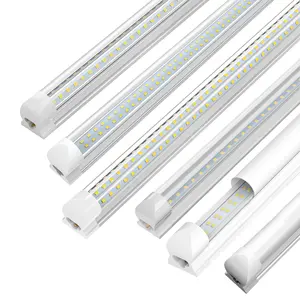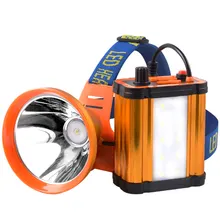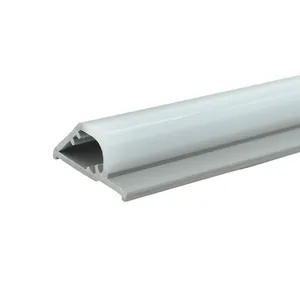What are Led Tubes
LED tubes are a modern lighting solution that serve as an energy-efficient replacement for traditional fluorescent tubes. Primarily used for indoor lighting, LED tubes are favored in commercial, industrial, and residential environments due to their longer lifespan and reduced power consumption compared to their fluorescent counterparts. They are designed to fit into the same fixtures as older tubes but offer a brighter, more natural light without the flickering or warming-up period associated with fluorescent tubes.
The technology behind LED (Light Emitting Diode) tubes is based on semiconductors that emit light when an electric current passes through them. This process is highly efficient as it produces very little heat compared to other lighting methods. LED tubes also contain no harmful substances like mercury, making them safer for users and the environment. They come in various sizes and can be clear or frosted, with options for dimming capabilities to cater to different lighting needs.
LED tubes are ideal for business owners looking to reduce their energy bills and maintenance costs, as well as for those aiming to minimize their environmental footprint. With a variety of color temperatures available, they can create the desired ambiance for offices, warehouses, hotels, and homes. Furthermore, due to their durability and long operational life, typically around 50,000 hours or more, LED tubes provide reliable illumination over extended periods without the need for frequent replacements.
Types of Led Tubes
LED tubes come in several types, each suited for specific applications and preferences. Understanding these varieties can help businesses choose the right lighting fixtures for their needs:
T8 LED Tubes: These are among the most common replacement options for fluorescent tubes. T8 LED tubes are energy-efficient and have a long lifespan. They are often used in office settings, schools, and hospitals due to their bright and consistent light output.
T5 LED Tubes: Slightly smaller in diameter than T8 tubes, T5 LED tubes are known for their high luminous efficiency and compact design. They are suitable for places where space is limited but high-quality lighting is required.
Integrated LED Tubes: These types of LED tubes come with built-in fixtures and do not require a separate ballast or starter. They are simple to install and can be used in various commercial settings such as warehouses and retail spaces.
U-bend LED Tubes: As the name suggests, these LED tubes bend into a U-shape and are typically used in places where space-saving is crucial. They're ideal for lighting up smaller areas without sacrificing brightness.
Circular LED Tubes: These provide 360-degree lighting and are commonly used in decorative fixtures. Their unique shape allows them to be used in applications where aesthetic appeal is just as important as functionality.
Each type offers distinct benefits that can cater to particular lighting needs from general illumination to accent lighting or task lighting in various environments.
How to Choose Led Tubes
Selecting the proper LED tubes for your business involves considering factors such as compatibility with existing fixtures, lighting requirements of the space, energy efficiency goals, and cost-effectiveness over time. For instance:
Assessing compatibility with existing fixtures is crucial. Some LED tubes can work with the existing fluorescent ballast (plug-and-play options), while others may require bypassing or removing the ballast (direct-wire or ballast-bypass).
The application heavily influences the choice of tube type. T8 LED tubes may be preferred in offices for their straightforward retrofitting process while integrated LED tubes could be beneficial in warehouses due to their ease of installation.
Consider the desired brightness (lumen output) and color temperature (measured in Kelvin), which affects the look and feel of the illuminated space. Warmer colors might be selected for hospitality environments while cooler temperatures may be chosen for task-centric areas like workshops.
Energy efficiency is another critical aspect. Look at the wattage of the LED tube compared to its lumen output to get a sense of its efficiency.
Additionally, evaluate if features like dimming capabilities or motion sensors could offer further energy savings based on how the space is utilized.
In summary, understanding these factors will help you make an informed decision that aligns with both practical requirements and financial considerations.
Best Led Tubes on Alibaba.com
Alibaba.com stands out as a premier online marketplace that connects businesses with a vast selection of LED tube suppliers from around the globe. With an expansive range of options tailored to various commercial needs, Alibaba.com simplifies the procurement process by providing access to thousands of products that cater to diverse specifications. Whether it's office buildings requiring consistent overhead lighting or warehouses seeking energy-efficient solutions, businesses can find suitable LED tube options on this platform.
The convenience of Alibaba.com lies not only in its extensive product listings but also in its user-friendly interface that supports easy communication with suppliers. Moreover, services such as Trade Assurance amplify buyer confidence by ensuring payment protection until order fulfillment is verified. Buyers can rely on Alibaba.com's commitment to facilitating secure transactions and its dedication to fostering international trade relations.
Additionally, Alibaba.com's mobile-friendly site enables on-the-go purchase decisions and supports local language communication – a testament to its mission of making global trade more accessible. From project installation services to specifying exact color temperatures or lifespans required, businesses can source customized solutions efficiently through Alibaba.com's comprehensive network of trusted suppliers.
Common FAQs for LED Tubes
What is the difference between T5 and T8 LED tubes?
T5 LED tubes are generally smaller in diameter and more energy-efficient than T8 LED tubes. They are designed for spaces where high-quality lighting with a compact form factor is required, while T8s are commonly used for general lighting purposes in a variety of settings.
How do I know if an LED tube is compatible with my existing fixtures?
To determine compatibility, you should check whether the LED tube is designed for plug-and-play use with an existing ballast or if it requires a direct wire/ballast-bypass installation. Additionally, the pin size and fixture type should match the LED tube you intend to use.
Can LED tubes be used in outdoor settings?
Certain LED tubes are designed for outdoor use and come with appropriate IP (Ingress Protection) ratings to withstand weather conditions. It's essential to choose LED tubes with the right IP rating for outdoor or moisture-prone indoor environments.
Are dimmable LED tubes available?
Yes, dimmable LED tubes are available and can be used with compatible dimming systems. Ensure that both the LED tube and the dimming system are matched for compatibility to avoid flickering or reduced lifespan.
What do color temperature ratings mean for LED tubes?
Color temperature, measured in Kelvin (K), describes the color appearance of the light emitted by an LED tube. Lower temperatures indicate warmer, yellowish light, while higher temperatures represent cooler, bluish light.
How long do LED tubes typically last?
LED tubes can have a lifespan ranging from 30,000 to 50,000 hours or more, which is significantly longer than traditional fluorescent tubes. The exact lifespan depends on the specific model and usage conditions.
What does an IP rating indicate on an LED tube?
An IP rating on an LED tube denotes its level of protection against solids (like dust) and liquids. The first digit indicates protection against solids and the second against liquids; higher numbers reflect better protection.
Is it necessary to remove the ballast for installing LED tubes?
It depends on the type of LED tube. Some require removal of the existing ballast (ballast-bypass) while others are designed to work with the ballast in place (plug-and-play).
How does one dispose of LED tubes safely?
LED tubes should be disposed of according to local regulations as they contain electronic components. Many areas have recycling programs specifically for electronic waste.
What is meant by 'lumen output' in LED tubes?
Lumen output refers to the amount of light emitted by an LED tube. A higher lumen output typically means a brighter light, while a lower lumen output indicates a dimmer light.
Can I replace a fluorescent tube with an LED tube without changing the fixture?
In many cases, yes. There are LED tubes designed to fit into existing fluorescent fixtures without extensive modifications. However, some may require bypassing or removing the ballast.
Are there special considerations for using LED tubes in enclosed fixtures?
Yes, when using LED tubes in enclosed fixtures, it is important to consider heat dissipation as it can affect the performance and lifespan of the LEDs. Make sure to choose LEDs that are rated for enclosed fixtures.
How do I choose between clear and frosted LED tubes?
Clear LED tubes emit brighter light suitable for task lighting or areas where maximum illumination is needed. Frosted tubes provide a softer light that reduces glare, ideal for general ambient lighting.
Can motion sensors be integrated with LED tubes?
Yes, some LED tubes are compatible with motion sensors which can help save energy by turning off or dimming lights when no movement is detected.
What does beam angle mean in relation to LED tubes?
Beam angle refers to the spread of light from an LED tube. A narrow beam angle provides focused lighting suitable for spotlighting or task lighting, while a wider beam angle offers broader light distribution great for general ambient lighting.





































 浙公网安备 33010002000092号
浙公网安备 33010002000092号 浙B2-20120091-4
浙B2-20120091-4